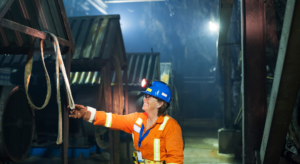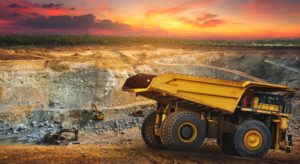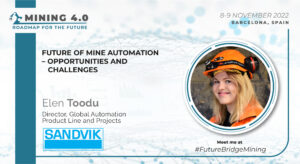A data analytics revolution in mining is empowering mining companies. They can achieve unprecedented operational efficiency, sustainability, and performance. That too amid volatile markets. Advanced analytics, powerful algorithms, digital twins, simulation tools, and intuitive visualization solutions are unlocking value across the mining value chain. It ranges from exploration to closure. So, those leveraging these exponential technologies gain significant competitive advantage. Moreover, laggard companies risk falling behind as margins tighten globally.
This detailed guide explores the future of mining landscape enabling customized data analysis, enhanced decision-making, predictive optimization, and automation based on accurate modeling. It also highlights how advanced software solutions integrate with IoT infrastructure and modern planning capabilities. This is to create intelligent, self-learning systems. Companies embracing connected, analytics-assisted operations are increasing productivity, lowering costs, extending asset longevity, and meeting stringent ESG targets. So, let us dive deeper into the data analytics revolution in mining ahead.
AI and Analytics Drive Optimized Planning
Mine planning is foundational, yet has always been limited by data silos and processing constraints. New solutions tackle these challenges by ingesting diverse datasets. This ranges from ore body models to equipment telemetry into multi-faceted analytics engines. Furthermore, integrated AI considers countless permutations of resource sequencing, material movements, and equipment usage across a unified model. This is to rapidly generate optimized dynamic plans attuned to strategic targets. This is around costs, sustainable development, and risk management.
Powerful algorithms crunch billions of data points from across operations. This is to understand complex interdependencies between mining stages. So, this multi-disciplinary perspective exposes optimization opportunities impossible for siloed human planners. Additionally, systems model long-term and real-time planning scenarios based on user inputs. Automated analytics also pinpoint the most efficient options for managers. This is to compare and select tailored plans balancing critical KPIs from safety to emissions minimization.
The software uses more data, past stats, and sensors to self-improve plans. Realized efficiencies feed back into algorithms for future decisions. AI learns iteratively, enabling scaled, customized automation in planning. This uses a unified data foundation, a big change from manual processes.
Detailed insight into mine development, equipment, and processing reveals challenges. Furthermore, optimized planning, powered by analytics, spots issues earlier. The data analytics revolution in mining proposes real-time mitigations, transforming productivity, safety, emissions, and more.
Digital Twins Enable Continuous Improvement
While modern planning generates enhanced schedules, digital twin technology executes plans more intelligently. Virtual dynamic 3D mine models interfacing with feeds. This is from IoT sensors across the operation using cloud analytics to contextualize real-time data. This is to optimize real-world decision-making in the future of mining:
- Telemetry from autonomous trucks, shovels, and drill rigs can be tracked. This is against the ‘digital twin’ mine layout. Then, it is processed by AI, and translated by dispatch systems. It is into instructions maximizing coordination between vehicle movements. It also includes assignments and progress against the plan.
- Sensors monitoring engine performance, materials conveyed, or environmental conditions relay data. This is to a cloud analytics platform. So, here AI compares readings against expected standards. It also alerts managers to the instant critical thresholds. These have the risk of being breached so interventions minimize disruptions.
- Changes like new infrastructure and incidents causing unplanned downtime automatically update the virtual ‘twin’. Moreover, simulation engines instantly propose revised plans or contingency measures. This is for management sign-off, keeping operations productivity on track.
Digital twins being one of the data analytics revolution in mining mirror mines digitally. It analyzes sensor data in the cloud. Anticipate and prevent issues before extended outages occur. Expert systems guide interventions, optimizing safety, compliance, and equipment longevity. This real-time support paradigm, powered by digital twins, improves mining continuously. It reveals hidden dynamics beyond human analysis, minimizing volatility. Expert analytics pinpoint minor deviations, sustaining peak productivity with lower risk.
Equipment Failure Prediction via Machine Learning
Unexpected mining stops harm revenue. Avoid this with condition monitoring. Machine learning analyzes truck, pump, and drill data for insights. Cloud-connected systems collect real-time equipment data. It recognizes vibration, temperature, and pressure patterns.
Machine learning spots small changes, often missed by humans. When deviations occur, alerts help operators and maintenance. This proactive data analytics revolution in mining extends equipment life through timely replacements. It provides warnings for reliability engineers, optimizing labor and schedules. Avoiding downtime saves substantial replacement costs annually. Investing in monitoring and machine learning proves worthwhile. It enhances asset optimization across mining operations.
Immersive Visualization Maximizes Insight Absorption
IoT infrastructure combined with advanced simulation, modeling, automation, and analytics engenders exponential intelligence gains for mining systems. However, assimilating these software-generated insights still requires human oversight for critical interventions. Data visualization technology enables personnel. This is to intuitively parse enormous integrated datasets. The data analytics revolution in mining goes beyond spreadsheet comprehension into interactive multidimensional environments. This is with customizable views revealing invisible connections key for strategic oversight:
- Geo-spatial data like ore grade block models and surveyed topographic maps overlay with digitally planned pits or underground drives. Manipulatable 3D mine representations also allow planners fluid experiment and adjust designs. It is based on graphical feedback toward engineering, commercial, and compliance goals.
- Telemetry streams paired with asset registers and maintenance logs populate operational centers. This is with real-time visibility over mobile equipment locations. It also includes benchmarks and health indicators via dashboards. It is also customizable to any oversight priority from fuel efficiency to weather hazard monitoring.
- Time-lapse drone footage reconstruction showing site progress combined with AR applications. The data analytics revolution in mining overlays Gantt charts and key project milestones onto emerging infrastructure. So, this keeps building alignment on schedule. This is as managers intuitively explore dynamic renders of the operation. It is through space and time from any perspective.
Whether onsite or remotely, visualization dashboards tuned to user needs across devices graphically communicate insights from vast analytics. As a result, this connects personnel with the most applicable data. So, it enhances and accelerates decisions through easily comprehensible graphical interfaces. Moreover, alongside planning and automation, the data analytics revolution in mining expands the human experience. This is regarding software-optimized operations.
Next-Generation Simulation Powers Design Optimization
For major capital decisions in mining infrastructure like processing plants, data centers and underground shafts, design simulation software provides critical reassurance on complex engineered investments. So, digital modeling builds augmented with physics engines and machine learning. As a result, countless permutations can be tested virtually with the data analytics revolution in mining:
- Structural simulations help engineers avoid underperforming concrete or steel component failures. These risk collapse, injury, and lawsuits. So, AI automatically runs side-by-side comparisons of endless combinational and dimensional adjustments. It helps to expose superior choices robustly handling anticipated load variabilities. It also exposes extreme weather events over decades of operation.
- Ventilation airflow behavior through any proposed shaft layout gets computationally modeled. It avoids oxygen deprivation or hazardous gas accumulation. So, operators examine 3D renders to identify ideal equipment locations to maintain air quality. This is across domains meeting stringent regulations through changing conditions.
- Thermal modeling ensures computer servers or pump rooms won’t overheat. This is during intense operations or summer peaks, preventing meltdowns. Moreover, the software iterates component, insulation, and HVAC combinations. The data analytics revolution in mining predicts temperature bands over multi-year horizons. The data analytics revolution in mining helps to determine how to build sustaining reliable environmental control.
Optimal designs are proven before groundbreaking. This is by exponentially boosting engineers’ capacity. This is to mimic constructions and test performance limits. That too through millions of simulated scenarios. So, avoiding deficiency-related rebuilds or outages saves vast sums over any mine lifetime in mining 4.0. Technologies also enable radical infrastructure innovation. It also enables customization securing reliability despite intensifying operational demands.
The Path Forward is Digital by Default
Shifting to connected, automated analytics boosts company performance and efficiency. It’s more than technology. Everyone’s involvement and cultural change matter. Leaders supporting change make operations using data more efficient. So, this prepares for global market challenges and enhances overall company adaptability.
Even with advanced tech like automation and AI, human oversight is vital in mining 4.0. Managing situations technology might not handle ensures good management. Teaching employees to maximize new software maintains a balance. It’s about merging human input and technological advancements.
Considering tight budgets, advanced tech, and AI benefit mining companies. Improving output efficiency, sustainability, and safety while cutting costs is also advantageous. So, a well-thought-out plan, updating IT infrastructure, and partnering with specialists are crucial. Long-term planning and openness to new methods contribute to successful mining innovation transition.
Training employees to manage human and digital aspects is essential. It sets the stage for benefiting from the data analytics revolution in mining. Smart systems save money, improve safety, and gain community support. This foundation ensures long-term success in automated, data-enriched mining activities.
4th Mining 4.0: Roadmap For The Future 2024 on 17-18 January 2024 in Phoenix, AZ brings together the most forward-thinking mining operators, technology innovators, and solution providers accelerating this digital transformation. This is through automation, electrification, digitization, and sustainability across the industry. There will be a variety of discussions, presentations, networking opportunities, and more to make sure you stand at the forefront of this transformation. So, secure your place today!





